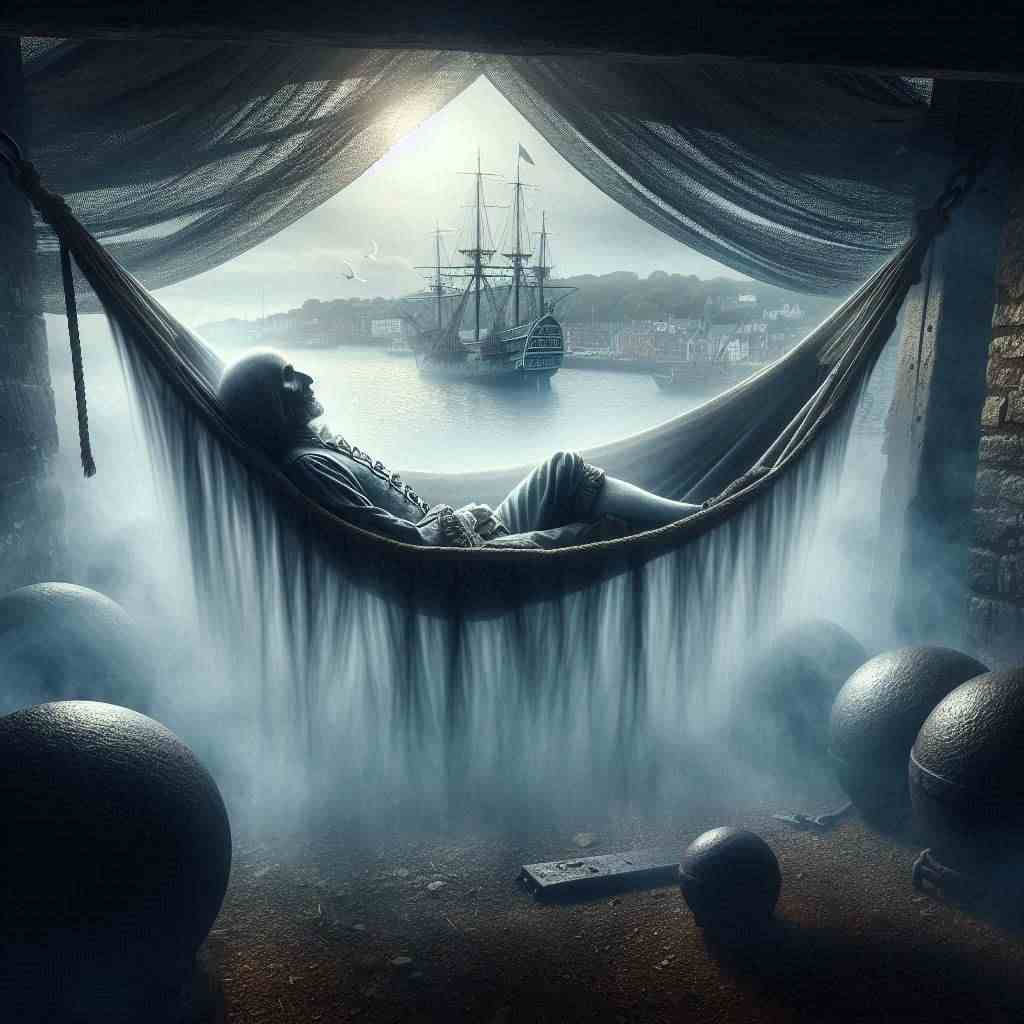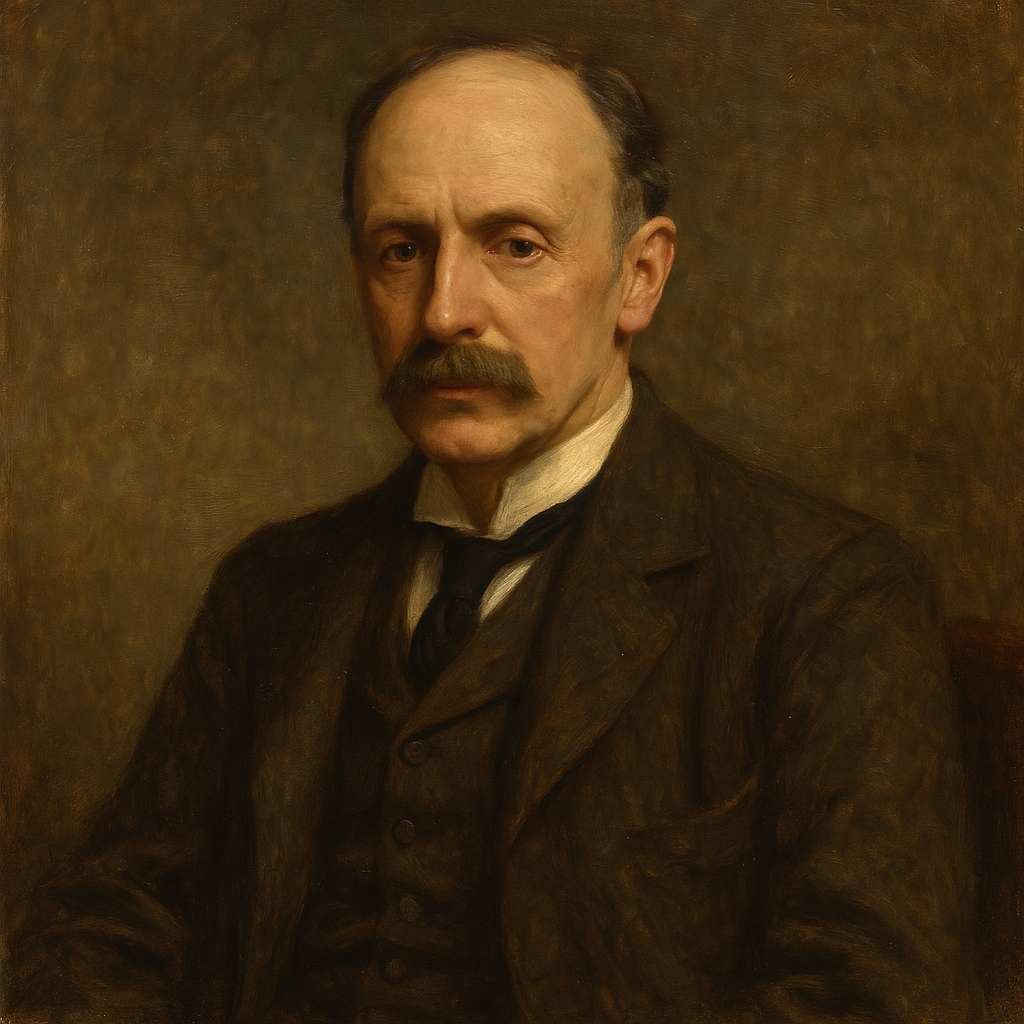Drake's Drum
Henry Newbolt
1862 to 1938

Drake he's in his hammock an' a thousand mile away,
(Capten, art tha sleepin' there below?)
Slung atween the round shot in Nombre Dios Bay,
An' dreamin' arl the time o' Plymouth Hoe.
Yarnder lumes the island, yarnder lie the ships,
Wi' sailor lads a-dancin' heel-an'-toe,
An' the shore-lights flashin', an' the night-tide dashin'
He sees et arl so plainly as he saw et long ago.
Drake he was a Devon man, an' ruled the Devon seas,
(Capten, art tha sleepin' there below?),
Rovin' tho' his death fell, he went wi' heart at ease,
An' dreamin' arl the time o' Plymouth Hoe,
"Take my drum to England, hang et by the shore,
Strike et when your powder's runnin' low;
If the Dons sight Devon, I'll quit the port o' Heaven,
An' drum them up the Channel as we drummed them long ago."
Drake he's in his hammock till the great Armadas come,
(Capten, art tha sleepin' there below?),
Slung atween the round shot, listenin' for the drum,
An' dreamin' arl the time o' Plymouth Hoe.
Call him on the deep sea, call him up the Sound,
Call him when ye sail to meet the foe;
Where the old trade's plyin' an' the old flag flyin',
They shall find him, ware an' wakin', as they found him long ago.
Henry Newbolt's Drake's Drum
Introduction
Henry Newbolt's poem "Drake's Drum" stands as a quintessential example of late Victorian patriotic verse, blending historical allusion with mythic resonance to create a stirring narrative of national identity and naval prowess. This analysis will delve into the poem's intricate layers, examining its formal structure, linguistic peculiarities, historical context, and thematic implications. By doing so, we will uncover how Newbolt's work not only celebrates a national hero but also constructs a complex dialogue between past and present, myth and reality, that speaks to the heart of British imperial identity at the turn of the 20th century.
Historical Context and Poetic Form
"Drake's Drum" was first published in 1896, during a period of heightened British nationalism and at the apex of the empire's global influence. The choice of Sir Francis Drake as the poem's subject is far from arbitrary; Drake, the Elizabethan sailor and explorer, represented for many Victorians the epitome of British naval supremacy and adventurous spirit. Newbolt's poem thus serves as a bridge between the "golden age" of Elizabeth I and the contemporary era of Queen Victoria, both periods of expansive British power and influence.
The poem's form is crucial to its effect. Composed of three eight-line stanzas, each followed by a refrain, "Drake's Drum" employs a ballad-like structure that evokes traditional folk songs. This choice of form connects the poem to a long-standing oral tradition of storytelling and myth-making, lending Drake's tale an air of timeless legend. The use of a refrain, "(Capten, art tha sleepin' there below?)", creates a haunting, repetitive quality that reinforces the poem's central conceit of Drake's eternal vigilance.
Linguistic Analysis
One of the most striking aspects of "Drake's Drum" is Newbolt's use of dialect. The poem is written in a stylized version of West Country English, the regional dialect associated with Devon, Drake's home county. This linguistic choice serves multiple purposes. Firstly, it adds authenticity to the narrative voice, grounding the poem in a specific geographical and cultural context. Secondly, it creates a sense of intimacy and immediacy, as if we are overhearing the private musings of a common sailor rather than reading a formal ode.
The dialect is most pronounced in phrases like "Yarnder lumes the island" and "Capten, art tha sleepin' there below?" Such constructions not only add color to the poem but also serve to differentiate between the voice of the narrator (presumably a common sailor) and the reported speech of Drake himself. This linguistic stratification subtly reinforces the class distinctions inherent in naval hierarchy while simultaneously presenting Drake as a man of the people, beloved by his crew.
Imagery and Symbolism
Newbolt's poem is rich in maritime imagery, creating a vivid sensory landscape that transports the reader to the deck of an Elizabethan ship. The opening lines, "Drake he's in his hammock an' a thousand mile away, / Slung atween the round shot in Nombre Dios Bay," immediately establish a sense of distance and danger. The juxtaposition of the peaceful image of Drake in his hammock with the menacing presence of "round shot" (cannonballs) creates a tension that persists throughout the poem.
The recurring image of "Plymouth Hoe" serves as both a geographical anchor and a symbolic representation of home and English identity. It is the focal point of Drake's dreams and the spiritual center of the poem. This use of a specific location to embody broader national ideals is a common trope in patriotic poetry, but Newbolt employs it with particular effectiveness here.
The drum itself, which gives the poem its title, is the most potent symbol in the work. It represents not only Drake's personal legacy but also the enduring spirit of English naval power. The instruction to "Take my drum to England, hang et by the shore, / Strike et when your powder's runnin' low" transforms the drum from a mere musical instrument into a talismanic object capable of summoning supernatural aid in times of national crisis.
Themes of Death and Immortality
One of the most intriguing aspects of "Drake's Drum" is its treatment of death and immortality. The poem presents Drake as simultaneously dead and alive, "slung atween the round shot" yet capable of perceiving current events and potentially returning to aid his countrymen. This liminal state speaks to the Victorian fascination with spiritualism and the afterlife, as well as to the broader cultural concept of national heroes achieving a form of immortality through remembrance and myth.
The refrain "Capten, art tha sleepin' there below?" takes on multiple meanings in this context. On a literal level, it could be understood as addressing Drake's physical remains. However, it also serves as a metaphorical call to action, implying that the spirit of Drake (and by extension, the spirit of English naval prowess) is merely dormant, ready to be awakened in times of need.
National Identity and Imperial Ideology
At its core, "Drake's Drum" is a poem about national identity and the continuity of English (and later British) naval tradition. By linking the Elizabethan era with the present day, Newbolt creates a sense of historical continuity that reinforces late Victorian imperial ideology. The poem suggests that the same spirit that drove Drake to circumnavigate the globe and harass the Spanish Armada still animates the British navy of Newbolt's time.
The final stanza, with its call to "find him, ware an' wakin', as they found him long ago," serves as both a reassurance and a call to action. It suggests that the spirit of Drake (and by extension, the indomitable spirit of Britain) will always rise to meet any challenge. This sentiment would have resonated powerfully with readers at the height of the British Empire, providing a mythic foundation for contemporary naval and imperial ambitions.
Conclusion
Henry Newbolt's "Drake's Drum" is a masterful example of how poetry can serve as a vehicle for national myth-making. Through its intricate blend of historical allusion, regional dialect, vivid imagery, and symbolic resonance, the poem constructs a narrative of English naval identity that transcends time. It speaks to the Victorian desire for continuity with a glorious past while simultaneously addressing contemporary anxieties about maintaining imperial power.
The enduring popularity of "Drake's Drum" in the decades following its publication attests to its effectiveness in capturing the spirit of its age. However, a modern reading of the poem must also grapple with its imperialist undertones and the way it simplifies complex historical realities in service of a nationalist narrative. Nonetheless, as a literary artifact, "Drake's Drum" remains a fascinating window into late Victorian cultural attitudes and a testament to the power of poetry in shaping national self-perception.
In its fusion of the mythic and the historical, the local and the national, "Drake's Drum" continues to invite analysis and interpretation. It stands as a reminder of the complex interplay between literature, history, and national identity, challenging us to consider how the stories we tell about our past shape our understanding of the present and our aspirations for the future.
This text was generated by AI and is for reference only. Learn more
Want to join the discussion? Reopen or create a unique username to comment. No personal details required!



Comments
No comments yet. Be the first to comment!